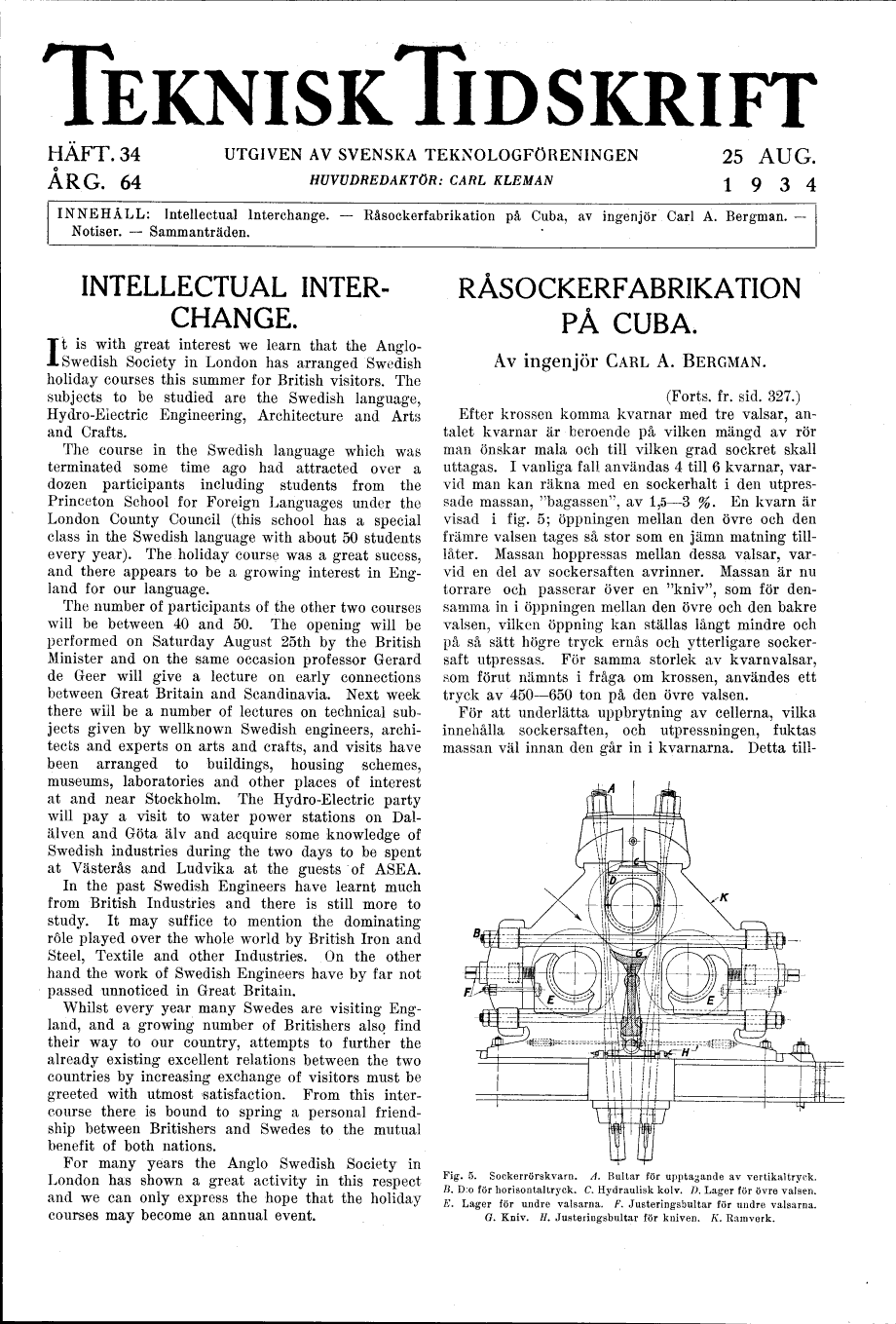
Full resolution (TIFF) - On this page / på denna sida - Häfte 34. 25 aug. 1934 - Intellectual interchange - Råsockerfabrikation på Cuba, av Carl A. Bergman

<< prev. page << föreg. sida << >> nästa sida >> next page >>
Below is the raw OCR text
from the above scanned image.
Do you see an error? Proofread the page now!
Här nedan syns maskintolkade texten från faksimilbilden ovan.
Ser du något fel? Korrekturläs sidan nu!
This page has been proofread at least once.
(diff)
(history)
Denna sida har korrekturlästs minst en gång.
(skillnad)
(historik)
TEKNISK TIDSKRIFT
HAFT. 34 UTGIVEN AV SVENSKA TEKNOLOGFÖRENINGEN 25 AUG.
ÅRG. 64 HUVUDREDAKTÖR: CARL KLEMAN 1934
INNEHÅLL: Intellectual Interchange. - Råsockerfabrikation på Cuba, av ingenjör Carl A. Bergman. - Notiser. - Sammanträden.
INTELLECTUAL INTERCHANGE.
It is with great interest we learn that the Anglo-Swedish Society in London has arranged Swedish holiday courses this summer for British visitors. The subjects to be studied are the Swedish language, Hydro-Electric Engineering, Architecture and Arts and Crafts.
The course in the Swedish language which was terminated some time ago had attracted over a dozen participants including students from the Princeton School for Foreign Languages under the London County Council (this school has a special class in the Swedish language with about 50 students every year). The holiday course was a great sucess, and there appears to be a growing interest in England for our language.
The number of participants of the other two courses will be between 40 and 50. The opening will be performed on Saturday August 25th by the British Minister and on the same occasion professor Gerard de Geer will give a lecture on early connections between Great Britain and Scandinavia. Next week there will be a number of lectures on technical subjects given by wellknown Swedish engineers, architects and experts on arts and crafts, and visits have been arranged to buildings, housing schemes, museums, laboratories and other places of interest at and near Stockholm. The Hydro-Electric party will pay a visit to water power stations on Dalälven and Göta älv and acquire some knowledge of Swedish industries during the two days to be spent at Västerås and Ludvika at the guests of ASEA.
In the past Swedish Engineers have learnt much from British Industries and there is still more to study. It may suffice to mention the dominating role played over the whole world by British Iron and Steel, Textile and other Industries. On the other hand the work of Swedish Engineers have by far not passed unnoticed in Great Britain.
Whilst every year many Swedes are visiting England, and a growing number of Britishers also find their way to our country, attempts to further the already existing excellent relations between the two countries by increasing exchange of visitors must be greeted with utmost satisfaction. From this intercourse there is bound to spring a personal friendship between Britishers and Swedes to the mutual benefit of both nations.
For many years the Anglo Swedish Society in London has shown a great activity in this respect and we can only express the hope that the holiday courses may become an annual event.
RÅSOCKERFABRIKATION PÅ CUBA.
Av ingenjör CARL A. BERGMAN.
(Forts. fr. sid. 327.)
Efter krossen komma kvarnar med tre valsar, antalet kvarnar är beroende på vilken mängd av rör man önskar mala och till vilken grad sockret skall uttagas. I vanliga fall användas 4 till 6 kvarnar, varvid man kan räkna med en sockerhalt i den utpressade massan, "bagassen", av 1,5-3 %. En kvarn är visad i fig. 5; öppningen mellan den övre och den främre valsen tages så stor som en jämn matning tilllåter. Massan hoppressas mellan dessa valsar, varvid en del av sockersaften avrinner. Massan är nu torrare och passerar över en "kniv", som för densamma in i öppningen mellan den övre och den bakre valsen, vilken öppning kan ställas långt mindre och på så sätt högre tryck ernås och ytterligare sockersaft utpressas. För samma storlek av kvarnvalsar, som förut nämnts i fråga om krossen, användes ett tryck av 450-650 ton på den övre valsen.
För att underlätta uppbrytning av cellerna, vilka innehålla sockersaften, och utpressningen, fuktas massan väl innan den går in i kvarnarna. Detta till-
<< prev. page << föreg. sida << >> nästa sida >> next page >>